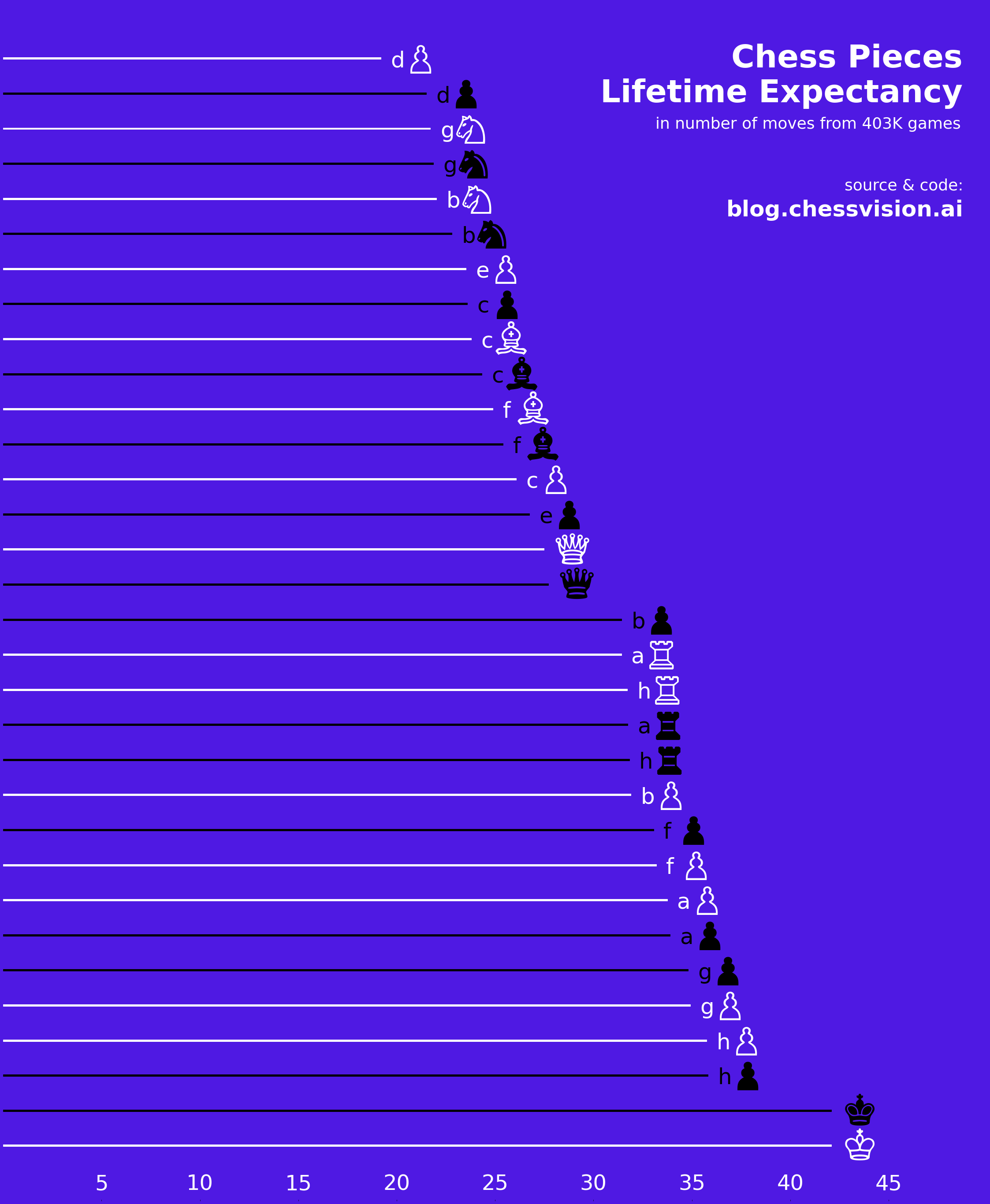A few weeks ago I was thinking about imbalances and asymmetries in chess, how they are created and how one can use them to their advantage. For example, trading a Bishop for a Knight, or the e-Pawn for the d-Pawn.
A natural study can arise from such thinking. Let define the Piece Lifetime first.
Piece Lifetime is the number of full-moves the piece was in the game. A piece is in the game until it gets captured or the game ends.
an immediate question is "What's the average Piece Lifetime for each of the 32 pieces?".
We use this average as an estimator of the Expected Piece Lifetime, and this is where the name of this study comes from.
I decided to write a code that takes a game in PGN format and computes Piece Lifetime for each of the 32 pieces. Each piece is uniquely identified by its starting square which helps distinguish pawns, knights, bishops, and rooks of the same color. I track the position of each piece during the game, and the piece's lifetime is determined as the number of full-moves when the piece is captured, or the game ended. There is one edge-case we need to handle - the pawn promotion. I decided to pick a simple rule: when a pawn promotes to a piece, no new piece is "born" after a pawn is promoted, instead, the pawn remains alive.
Then, in order to have some meaningful results, we need to run this code on many games and compute the mean of pieces lifetimes.
Data source
I used the Lichess Elite Database created by @nikonoel, specifically games played on October 2020 from this database - there are just over 403K such games there. It is an awesome resource as it is essentially the filtered Lichess games database to only keep games by players rated 2400+ against players rated 2200+, excluding bullet games. All the credit for the data goes to @nikonoel and the Lichess Team.
Source code
The complete source code for the study in the notebook form is available here: https://github.com/chessvision-ai/chess-piece-lifetime-expectancy
Results
The plot is generated by the provided source code.
Observations
The first interesting observation is that White's d-Pawn lives the least number of moves, and the gap to the second shortest living, Black's d-Pawn, is more than one could expect
A trivial observation is that Kings have the longest Lifetime Expectancy, and of course equal (you should know why?). They live around 42 moves which also denotes the average number of moves in a game.
King-side Pawns live much longer than the Queen-side Pawns in general. The only exception are a-Pawns that live a bit longer than f-Pawns. Also, a-Pawns are by far the longest living among Queen-side Pawns.
Queens also have almost equal Lifetimes, and this can be explained by the fact that most often their Lifetime ends when one Queen is traded for the other Queen.
An interesting observation is that all Knights have shorter Lifetime than all Bishops.
One can easily notice that there is a substantial difference between the lifetimes of the Queens and all longer living pieces. These pieces are only some Pawns, mostly outside, Rooks and Kings, which might be explained by the fact that these particular pieces occur way more often in the endgames.
b-Knights live longer than g-Knights and Black's b-Knight live longer than White's. It might be explained by it being an important defensive piece in Black's camp.
f-Bishops live longer than c-Bishops.
The longest living center Pawn is Black's e-Pawn.
Open Questions
- An interesting study might be to compare Pieces Lifetimes across different ELO ratings, or even between games of two Grandmasters.
- Comparing deviations between Pieces Lifetimes across different ELO ratings also seems quite interesting

